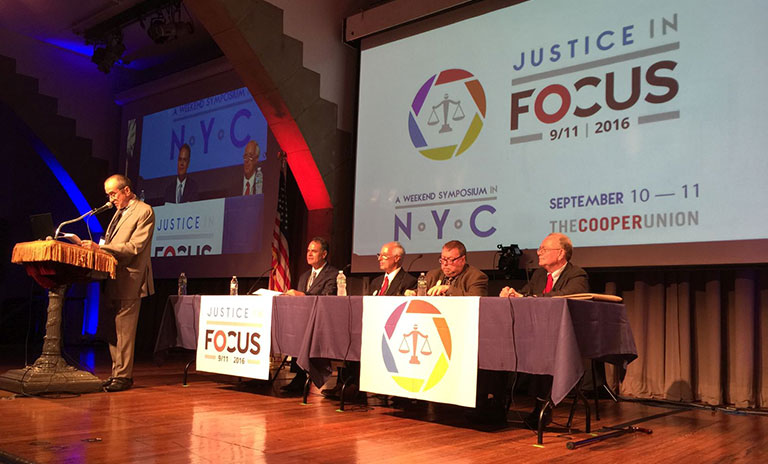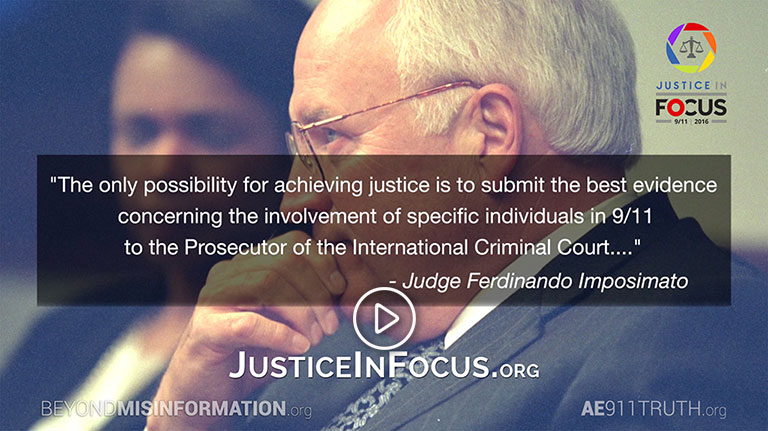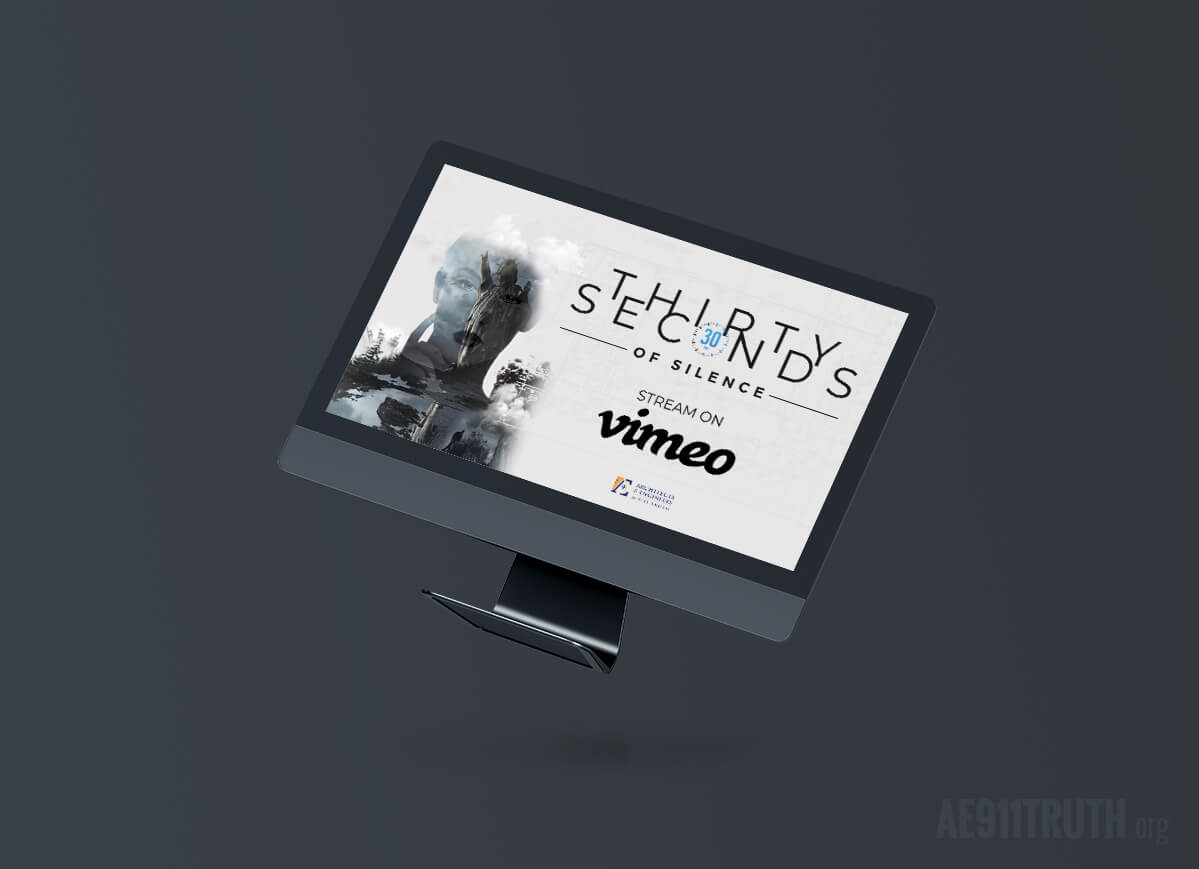It's been 15 years since the tragic events of September 11, 2001. As if the act of studying history were no longer something that people do, we often hear the refrain, “It’s time to move on.” And yet every year in the month of September, bought-and-paid-for politicians and a subservient media join to reinforce the time-honored fairy tale that is the official story of 9/11. This epic work of fiction — a strategic script of omissions, unconnected dots, and impossible physics — continues, each and every day of our lives, to be used as justification for endless war, the erosion of civil liberties, and an ever-expanding surveillance state.
To renounce the official fairy tale and chart a path toward its permanent dismantling, a two-day symposium was held on September 10th and 11th in the Great Hall of the Cooper Union. Chosen for its historical significance — the site of Abraham Lincoln's famous 1860 address and less than two miles from the World Trade Center — the Great Hall was an ideal location to commemorate the 15th anniversary of 9/11, to honor the thousands of civilians and first responders who lost their lives that day, and to tell the truth. The hall was, in short, the perfect place to put JUSTICE IN FOCUS.
Day One Morning Session: Welcome to 'Justice In Focus: 9/11 | 2016'
Introducing the first session of the weekend was New York City activist Les Jamieson, who paid tribute to the victims of the attacks. Expressing optimism for the future of 9/11 Truth, he announced that the movement was “embarking on a new evolutionary stage of research.” And, based on the lineup of venerable human rights activists, lawyers, scholars, chemists, and other esteemed professionals participating in the symposium, the audience had good reason to share Jamieson's hope.
Mark Crispin Miller, professor of Media and Culture at New York University, celebrated author, and master of ceremonies for the Saturday session, was first to take the podium.
In his opening remarks, Miller explained what JUSTICE IN FOCUS was not: “We are not remembering victims in an authoritarian and war-like spirit, where we try our best to revive the horror and pathos of that original moment in order to justify a prolonged military response all around the world.”
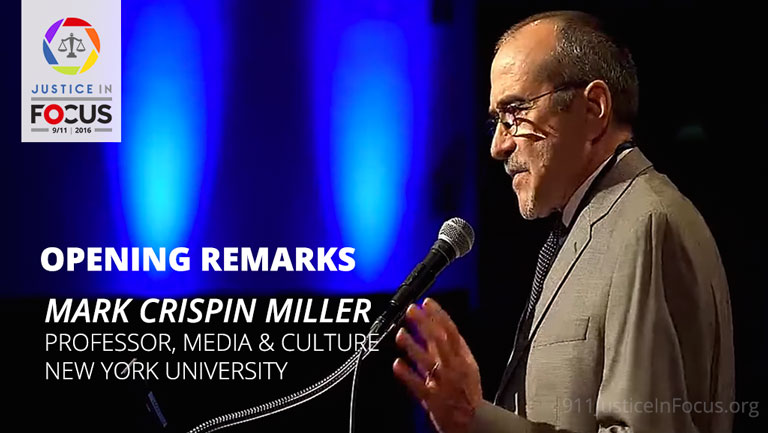
Rather, he noted, the way to respond to this crime against humanity is to honor the victims “in the best way possible by trying to seek justice for them by figuring out what really happened and who really is responsible.”
Miller also maintained that 9/11 was a crime against democracy in that it involved a traumatic event that “did what such events always do in history and are meant to do, which is to exalt executive authority beyond the reach of any kind of popular control” and which did “what war has always done — doing what war, the framers feared, would do to our system, if it should ever manage to take over.”
In addition, Miller cited a “subtler” crime against democracy: As with the JFK assassination, where the majority of Americans didn't believe the official account, so now do they not believe the government's version of 9/11. Thus, they are “smeared” with the label of “conspiracy theorists” which, according to Miller, “amounts to a strong suggestion that the American people are idiots — nuts that they could believe these things.”
In his wrap-up remarks, Miller pointed to encouraging signs and reasons to be hopeful. For one: “If Pete Carroll, the head coach of the Seattle Seahawks, is now a 9/11 Truther, we're obviously doing something right.” And for another: “I can tell you, as a professor, my own students are no longer intimidated by the 'conspiracy theory' meme. It isn't working anymore.”
Miller then introduced the next speaker, Daniel Sheehan.
Day One Morning Session: The Existence of Indisputable Evidence and the Courts
Danny Sheehan is one of America's best-known and most influential constitutional and public interest attorneys. Buttressed by his half-century of legal practice, Sheehan explained why the 9/11 case being brought forward that weekend was not a trial, but a Rule 11 inquiry — that is, a public consultation with experts, designed to demonstrate the existence of evidence sufficient to pursue a case.
To avoid confusion, Sheehan clarified that “this is not the same case as one already filed, called IN RE: TERRORIST ATTACKS ON SEPTEMBER 11, filed in 2002 by the Motley Rice law firm.” That case is currently on appeal after being initially dismissed in 2005 on two grounds — the first involving sovereign immunity; the second, insufficient evidence.
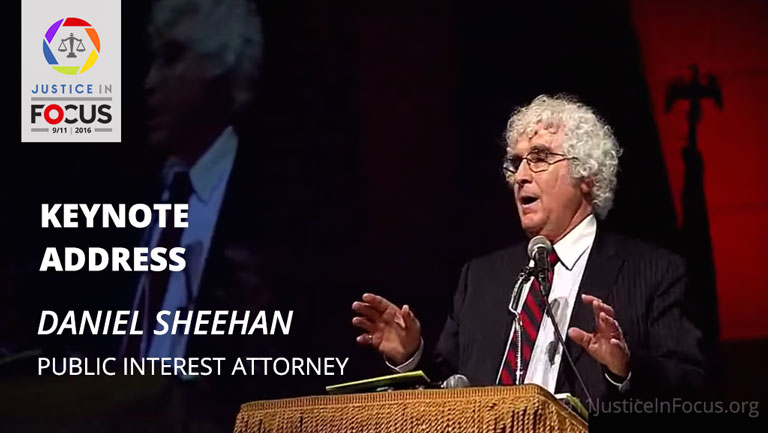
In light of that decision, Sheehan called attention to a new congressional act, S. 1535, the Justice Against Sponsors of Terrorism Act (JASTA), that removes sovereign immunity from any nation state that in any way supported the 9/11 attackers. He also pointed to the recent release of 28 pages of information about 9/11 that had been kept under wraps by Congress for 13 years.
According to Sheehan, these new revelations lend great hope to the new case as it moves forward in the appeals process. Over the course of the weekend, he said, a new theory of the case would be discussed. It alleges collective negligence, or “joint tortfeasors,” and asserts that there were joint conspirators who worked alongside those conspirators who have been already charged in the Motley Rice civil case.
Day One Morning Session: Education and Research Lay the Groundwork for Justice
Following Sheehan at the podium was Richard Gage, founder of Architects & Engineers for 9/11 Truth (AE911Truth). Gage told of his first foray into the facts of 9/11 a full 10 years earlier. It was anger over feeling duped, he said, that pulled him in and motivated him to put his architecture career on hold and launch his truth-vetting organization.
Summarizing AE911Truth's progress, Gage told of inroads made at this year's AIA convention, where a resolution presented to delegates asked the national organization of architects to adopt a position statement supporting a new investigation into the collapse of World Trade Center Building 7 (WTC 7). According to Gage, the first time the resolution was introduced, a year earlier, the AIA vigorously pushed back. One delegate falsely alleged that WTC 7's demise was caused by diesel fuel, even though government engineers at the National Institute of Standards and Technology had already ruled out that possibility. The AIA's treasurer, charging that the resolution would require “a substantial commitment of both staff and financial resources,” ignored the fact that it was a no-cost position statement.
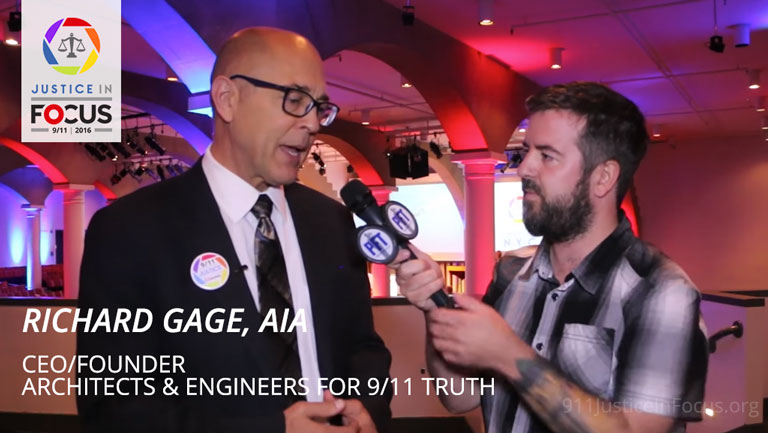
Though resistance from AIA's leadership resumed at this year's convention, the good news, Gage reported, is the threefold increase in AIA members voting for the resolution from one year to the next.
Gage then pointed to another AE911Truth project — a billboard across from The New York Times Building that shows a WTC tower exploding. It is proof, he said, that “education and research lay the groundwork for justice” as they “erode support for the official 9/11 story step by step.”
After observing that “in the academic community, the resistance is diminishing,” Gage referred to the AE911Truth-funded study at the University of Alaska Fairbanks (UAF) that will determine whether fires caused WTC 7 to collapse. Then he introduced the man in charge of that study, Dr. J. Leroy Hulsey, chairman of UAF's Civil and Environmental Engineering Department and a structural engineer who specializes in forensic analysis of building failures.
Hulsey summarized the work that he and his two-man team of students — one a recent Ph.D. graduate and the other a Ph.D. candidate — have undertaken. He listed the software tools they're using, described their methodology, and cited the factors they are taking into consideration in their finite element modeling. Hulsey then announced that the team's analysis over the past year has led them to a conclusion completely contrary to NIST's — namely, that fire categorically did not cause the collapse of WTC 7.
The engineer's findings prompted emcee Miller to reflect on how long it has taken for researchers in the academic engineering community to question and refute the official explanation of WTC 7's collapse — and reminded him of the Mark Twain axiom, “A lie can travel halfway around the world while the truth is still putting its boots on.”
Miller then introduced the Honorary President of the Supreme Court of Italy, Judge Ferdinando Imposimato, who made the keynote speech.
Day One Morning Session: Keynote Address — 9/11 as 'Strategy of Tension'
Judge Imposimato opened his speech with penetrating quotations from early Roman and Greek scholars. “Cicero told us 'In primis hominis est propria veri inquisitio atque investigatio' — 'The first object of every man is searching and investigating the truth.' . . . One of the greatest ancient historians, the Greek Thucydides, said: 'We must know our past to understand the present and be able to predict the future.'”
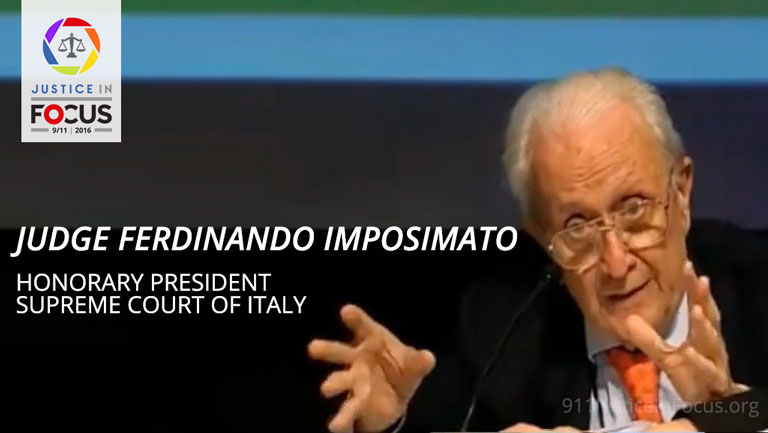
He then explained the quotes' relevance to the pursuit of 9/11 Justice: “Our history, as we know it, is polluted with fabrication, silence, and misinformation, starting from the true masters of the massacre and political crimes. This is because modern democracies, often masking tyrannical regimes, use the media as instruments of disinformation and distortion of people's consciences to wage mass fear for preemptive wars. There is no future without truth and justice.”
Analyzing media distortion, Imposimato spoke of the “strategy of tension,” a concept dating back to 1947, when Italian bandit and separatist leader Salvatore Giuliano, who supported the separation of Sicily from Italy and Italy's annexation by the United States, led the Portella della Ginestra massacre, in which 11 people were killed and at least 27 wounded in the municipality of Piana degli Albanesi.
Imposimato laid out the context for that mass murder: “In April [of 1947], the People's Block party won the elections in Sicily against the Christian Democratic Party. This victory alarmed the landowners, the Italian politicians, and the United States. In response, on May 1st, Giuliano's men fired a series of machine-gun rounds at the demonstrators, killing adults and children. There were also some Italian politicians amongst the instigators of the massacre. The United States government, for its part, provided weapons and financial support to the authors of this attack. The American consul in Rome was accused of having provided weapons. The American Michael Stern confirmed that the US had supplied Giuliano with weapons. Portella della Ginestra was always reproduced during the strategy of tension — [and it] would involve the Mafia, politics, and institutions.”
The judge went on to identify a long list of nefarious partners in the strategy of tension — in particular Gladio/Stay Behind, which he defined as “a military organization belonging to the Deep State, which interfered systematically with Italian democracy, destroying or preventing progressive governments. The parliamentary Commission, led by the honorable Republica Libero Gualtieri, declared that Gladio/Stay Behind was an illegal organization operating under US government control.”
Some years ago, when contemplating whether the Deep State really existed, Imposimato decided to do his own research on the subject. He found three important documents from 1967 and 1969 identifying the Deep State, the strategy of tension, and the hidden war in Italy, all of which confirmed his suspicions. According to the judge, “The 1967 document stated, 'The charges of interference in the internal politics of European countries against the U.S. Intelligence are absolutely true.' . . . The report recognized that 'the international pressure groups are bringing the free world into disorientation and chaos,' and that was a strategy of tension.”
After citing numerous other examples of the strategy of tension, Imposimato ended with a rousing statement: “We believe that democracy is transparency and control. We believe the state needs justice more than welfare. A state could exist without welfare but not without law and justice. We and the victims of 9/11 are awaiting justice and law — respect for human rights and due process of law.”
When Miller retook the podium, he, too, referenced Operation Gladio and mentioned a book with that title, in which author Paul Williams proved that “Gladio has ravaged Italian democracy to a grotesque extent. Many people have died simply for trying to investigate that history,” Miller asserted.
Interestingly, Paul Williams had been “a neoconservative who was a regular on Fox News and a consultant to the FBI on Islamic terrorism. That all changed,” said Miller, “after he did an exposé of Islamberg, [a hamlet in Upstate New York with] a training facility for radical converts to Islam who had made the conversion in our prisons. He discovered [this] federally supported training facility in Upstate New York for Islamic terrorists and wrote a piece about it. The scales fell from his eyes. And also he fell from the pedestal he'd been on. He was no longer invited to come on Fox and talk about 'stuff' like this.”
Day One Morning Session: Guest Speakers
When listening to speeches devoted to the subject of 9/11, an audience has little reason to laugh. Unless, that is, the speaker is Lionel, a trial lawyer, legal analyst, and Emmy Award-winning nationally syndicated TV personality known for his hyper-energy and humor. On this Saturday in the Great Hall, Lionel was his usual high octane, insightful, droll self. He masterfully called out propagandists, skewered the “conspiracy theory” meme, and roundly ridiculed “the bought-and-sold, sock puppet, Ted Baxter, mainstream media” for their role in encumbering freedom of thought and the pursuit of truth.
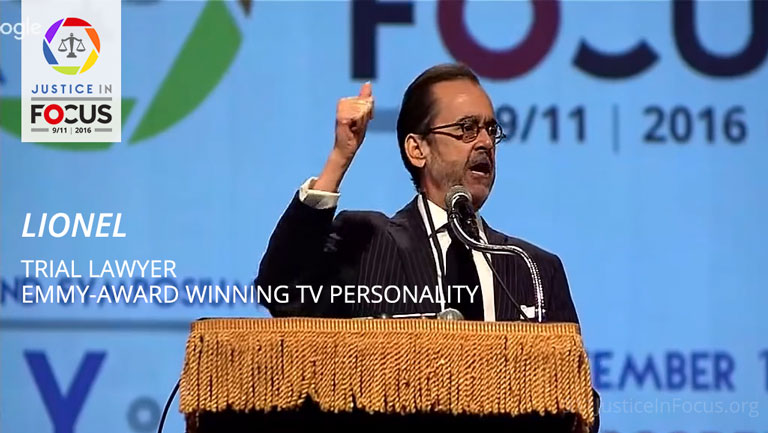
Lionel's speech, as delightful as it was compelling, reminded us that, while we owe much to the dedicated technical professionals who have produced voluminous forensic, eyewitness, and circumstantial evidence, we mustn't forget the persuasive potency of literary talent and other artists. A spoonful of Lionel's medicine, if taken by every American, could do wonders for their ability and willingness to assimilate the facts of 9/11. Too, his incisive wit is a booster shot for activists in the movement, who sometimes weary of waking up the public to the truth.
One of the most heart-stirring talks during of the two-day event was given by Bob McIlvaine, father of Bobby, who, on the morning of 9/11, was killed in an explosion as he was about to enter the lobby of the North Tower. After speaking briefly and tearfully about his son, Mcllvaine thanked Richard Gage for inspiring his wife, Helen, to finally join him at an occasion of this magnitude. According to Mcllvaine, her change of heart was inspired by a presentation in which Gage laid out the indisputable evidence for controlled demolition. Mcllvaine closed by reading an essay that he, his wife, and their son Jeffrey wrote. “Connecting the Dots” is a sobering look at the McIlvaine family's journey into “the ugly truths that continue to dance on our eyelids.”
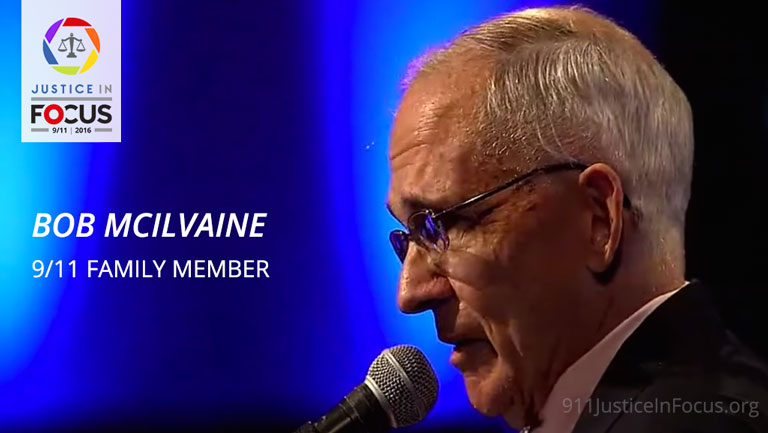
The last speaker of the morning session was Dylan Avery, writer and director of the 9/11 documentary Loose Change. Despite its shoestring budget, the film's first version in 2005 was a ground-breaking exposé that challenged the official story of 9/11 and is still regarded by many as the first Internet blockbuster. Speaking to the continued relevance of 9/11, Avery cited a common inconsistency: “Some people will tell you, when you bring up 9/11, to get over it, forget about it . . . it's been 15 years. But then you turn on the TV and someone is using it as justification for 'whatever.'”
Avery, who made Loose Change when he was graduating from high school, described his life upon the release of the film. “I was working at Red Lobster when the original Loose Change came out, and one of the first things I did was, and actually, it's kind of funny, I was sitting around waiting for the shipment to show up so I could grab a DVD and run to work with it, because I had been annoying/pestering my coworkers for the last . . . . 'I got this film, it's about 9/11. What's it about? I'll just give you a copy, it's easier if I give you a copy, you watch it and you can get back to me.'”
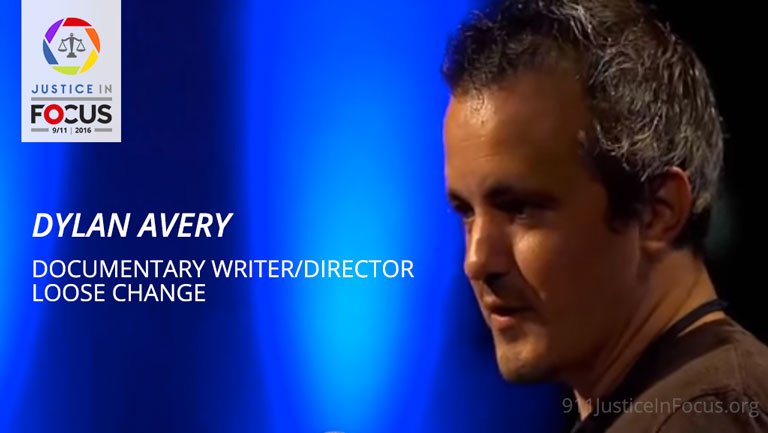
“I was so excited. A giant freight truck shows up with boxes of DVDs. I'm like 20 years old at this point.” After giving the DVD to a coworker, he got a call to go out to KPFK in California. There he did a screening tour in churches and cinemas. When he returned to New York, he discovered he'd lost his job. Instead of trying to get it back, Avery decided to see where the documentary would take him. He then made a second version of the movie, and through a fortuitous chain of events, ended up on Fox News with the opportunity to discuss his work. [The final cut of Loose Change came out in 2009.] Avery currently is making a documentary about the militarization of police departments and police brutality.
Day One Afternoon Session: Opening
Welcoming attendees back from lunch, emcee Mark Crispin Miller made a wisecrack allusion to the post-9/11 police state mantra: “If you see something, say something.” As the laughter died down, he introduced a table of panelists for the next presentation: attorney, whistleblower, and author J. Michael Springmann; Washington-based investigative journalist Wayne Madsen; activist Les Jamieson; and Executive Intelligence Review senior editor and author Jeffrey Steinberg.
Day One Afternoon Session: Creating Our Enemies — From the Mujahadeen to ISIS
Panelist J. Michael Springmann, author of Visas for Al Qaeda: CIA Handouts that Rocked the World, took the podium to discuss how the issuance of visas to Saudis, above the objections of the American consulate, led him to the discovery of an insidious effort by the US government to recruit an army in Afghanistan to fight the Russians. “What the United States did in the 1970s and 1980s was create a terrorist organization,” Springmann related. “It recruited the Mujahadeen for the war in Afghanistan against the former Soviet Union. These were some of the worst possible people that the United States government and its oppressive and reprehensible allies, such as Saudi Arabia's and Pakistan's Inter-Services Intelligence group, could put together.” He closed with the plea, “Let's move forward and make these people accountable for what they do.”
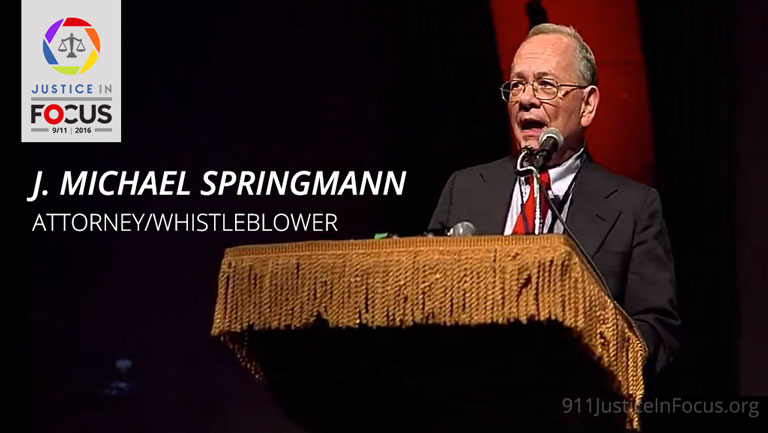
Next up was panelist Wayne Madsen, who recounted the origins of the Islamic state. “You know, after 9/11, Bush, Cheney, and the rest of that cabal told us, 'Give us some of your privacy — we're going to institute this Patriot Act — so we'll never have to face another major terrorist attack in the United States.' Reluctantly, we had to go along with it, because our representatives voted for it. There were never any hearings on it. Now [we can ask] people in Orlando, San Bernardino, Fort Hood, and other places, 'How did that work out for you, giving up all those constitutional rights [for the promise of] increased security?' It didn't happen. And what I'm going to suggest to you as the reason it didn't happen was [that] when Al Qaeda's shelf life expired, they said, 'We need to rebrand it.' And how did they rebrand it? They rebranded it 'The Islamic State.'” Otherwise known as ISIS or IS or ISIL.
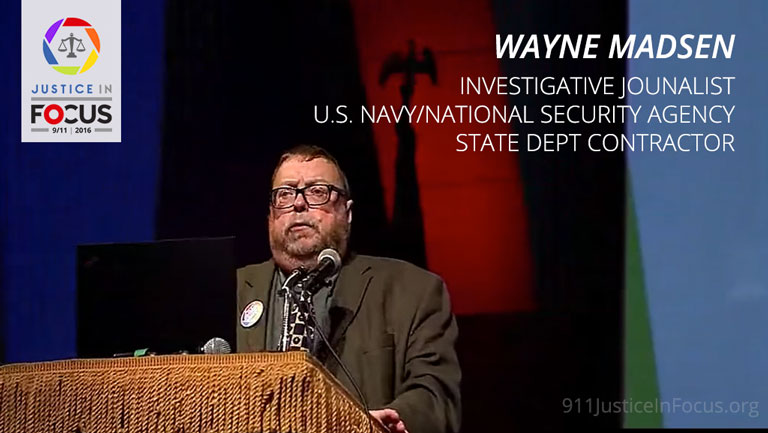
“ISIS,” Madsen explained, “is a creation of various intelligence services, including our own. And the chickens have come home to roost.” The journalist concluded his presentation by agreeing with Imposimato's assessment: “I applaud what the judge said earlier. This is an outgrowth of the strategy of tension and it's not just the United States that suffers. It's countries around the world.”
Day One Afternoon Session: 28 Pages to 80,000 Pages — Transparency as the Path to Justice
The third panelist to speak, Les Jamieson, articulated his view of the importance of the newly released 28 pages. He said he believes their contents are the key to understanding what really happened on 9/11. Jamieson quoted from a British-based Saudi publication, “What happened in the Twin Towers was a purely American action, planned and carried out within the US. Proof of this is the sequence of continuous explosions that dramatically ripped through both buildings . . . . Expert structural engineers demolished them with explosives, while planes crashing into them only gave the green light for the detonation — they were not the reason for the collapse.” Jamieson added his own conclusion: “This would have not come out, folks, were it not for the 28 pages being released.” After laying out what he foresees is down the road with the recent passage of JASTA and the release of the 28 pages, Jamieson closed with a request. “We need everyone [who is] listening . . . to help us spread the word and multiply our numbers and become what's necessary — a political constituency. The 28 pages has been a platform to create a political constituency . . . a broad based political constituency that knows the official narrative is false and that demands full disclosure and justice under the law.”
Executive Intelligence Review senior editor Jeffrey Steinberg, the fourth and last panelist, opened by congratulating the 9/11 families and others for their “persistent mobilization” to effect the release of the 28 pages and to spur Congress into passing JASTA. He called the bill a testament to their belief that “Truth has no statute of limitations,” then went on to declare, “The purpose of these two days is to develop a new thesis and the basis for a new legal action.” He even proposed a new legal action, based on new information revealed in the 28 pages, by spotlighting a central figure, from the standpoint of the Saudi government — Prince Bandar bin Sultan.
Steinberg elucidated, “Now, Prince Bandar is not a Wahhabi. Prince Bandar is known as the Prince from Glenfiddich. He's got a greater affinity for Cuban cigars and single malt scotch, and other things that I won't even discuss here, than anything having to do with the austere brand of Islam practiced in Saudi Arabia. In fact Prince Bandar was effectively a member of the Bush family. He was widely called Prince Bandar Bush. Why is it,” Steinberg continued, “that somebody who was, among all of the Saudi officials, the single most trusted representative from the standpoint of the Bush/Cheney administration, provably deeply involved in the financing and logistical support of the 9/11 attacks?”
Steinberg wrapped up his presentation by addressing the audience, “Everybody here, everybody in the extended family who is fighting for the truth about 9/11, whatever the specific focus of your efforts is, the cumulative effect is that the government in Washington, that pillar of obstinacy, has been moved. And we've got to now take advantage of the fact that, once you get something moving, momentum is with you. Don't let it stop. Let's go on from here and let's develop a strategy so that we get at the real truth.”
Day One Afternoon Session: Lessons from Landmark Cases Applied to Prosecuting 9/11
Daniel Sheehan returned to the podium to give the afternoon keynote presentation. He announced that the objective of the afternoon session was to point out some of the legal principles necessary to discuss the viability of a parallel case to the IN RE: TERRORIST ATTACKS ON SEPTEMBER 11 case filed by the Motley Rice law firm. The question as to whether certain parties involved in the crimes were “simply incompetent” or whether their involvement was intentionally criminal is one that needs to be answered before moving forward. The question reminded Sheehan of an old adage in law which affirms that a guilty party “would much rather be considered a fool than a knave.”
Based on his vast legal experience, Sheehan laid out a number of considerations necessary to build a legal team that is fit to engage in and pursue the politically charged evidence of 9/11. At the top of the list was his warning that any lawyer on this team should be prepared to be aggressively attacked. Sheehan then went on to describe the immense political hurdles that inevitably present themselves in high-profile cases. Calling 9/11 one of those crimes “so grave that they cause the very foundation of the law itself to tremble,” he urged all forms of media, activists, and organizers to be profoundly and tenaciously involved if a successful outcome is to be rendered.
Day One Afternoon Session: Justice In Focus — Toward Prosecuting the Crimes of 9/11
After his keynote speech, Sheehan took part in a Q&A with a roundtable of attorneys, during which he answered an attendee's question, “Why doesn't basic criminal procedure apply to the government?” with this reply: “The basic criminal procedures have to be undertaken by the government themselves. They have been vested with the sole authority to use violence on behalf of their position — they're armed and dangerous.”
Sheehan closed with two more important points: It's incumbent upon the people to prove irrefutably that the official story is a lie, and the most formidable constituency to advance the case is the families of the victims.
Day One Afternoon Session: 9/11 Truth Action Project — Lift Off
Richard Gage was invited to announce the launch of a new organization, the 9/11 Truth Action Project (TAP). Headed by Bill Jacoby, its stated mission is to “[o]rganize a global groundswell of civic support for an independent, transformative congressional investigation that delves deeply into the forces that made 9/11 and its cover-up possible, and paves the way for justice, peace, and restoration of civil liberties.”
Jacoby spoke next. “We have taken the easy road too long,” he remarked. He made the point that it's time for the people themselves — not just Congress, the media, and the courts — to step up and face up to this crime. After giving an overview of TAP, Jacoby introduced the chairman of TAP's board, Wayne Coste, an electrical engineer who has long been active in 9/11 Truth outreach activities.
Reminding the audience that “physics never takes a day off,” Coste discussed the nuts and bolts of TAP and laid out some of its organization-building strategies. Others involved in TAP, including Texas attorney Jane Clark, Washington, D.C., attorney Andrew Krieg, and board members Sara Nelson and Sander Hicks, weighed in on various strategies the group plans to employ in carrying out its mission.
Day Two Morning Session: Introduction
Kicking off the September 11th morning session was public interest attorney and whistleblower Mick Harrison, who introduced attorney, barrister, author, and Sunday's master of ceremonies, Dr. William Pepper.
Pepper admitted that he hasn't been formally engaged in the investigation of 9/11, but complimented those who are: “I'm here out of respect for their work. It's important to understand, right at the outset, that this work, and that which will go on for many years, has been categorically demeaned, criticized, and distorted by the ruling forces in this country and the governments of the day.”
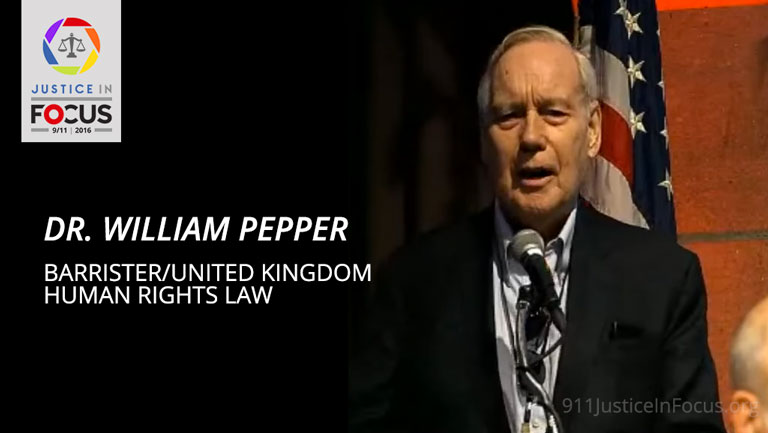
He continued, “This effort has been formally underway since 1964. There was a CIA dispatch in 1964, primarily designed to discredit critics of the John F. Kennedy assassination. That dispatch is 10-35-960. It was designed to establish a program that would discredit and to coin the phrase 'conspiracy theorists' and to apply 'conspiracy theorist' to any individual or group who chose to criticize, in that instance, the Warren Commission report. But beyond that, in later years, [it covered] any effort at all to bring truth to the assassinations that took place in the '60s.”
“Now, it's important to put that in the context of 9/11, because whatever you do here, and all of the excellent work that has been done here, will be coined that way. And it has to be overcome. It has to be understood that that program is still in effect, and they will have applied it to all of the work the architects and engineers have done, the lawyers and lawyer panels have done — because 9/11 not only changed what happens in this country, but it changed the world. And it gave us a paradigm for endless war, and we live with that today.”
Pepper told how, prior to the bombing of the Murrah building in Oklahoma City in 1995, when he was at Oxford University, he received in the mail “an unsigned schematic, that was supposedly drafted by a member of the [Army] Corp of Engineers, who said his conscience would not allow him to rest — that he wanted it to be known that they wired the Murrah Building.”
Referencing a chapter from his latest book, The Plot to Kill King, that deals with media disinformation, Pepper said, “They started media disinformation in 1968 and they carried it forward to the present time.” He reminded everyone of what journalist Carl Bernstein brought to light back in 1978 — that the CIA had 400 agents attached to American media, including The New York Times. According to Bernstein, “From 1950 to 1966, about ten CIA employees were provided Times cover under arrangements approved by the newspaper’s late publisher, Arthur Hays Sulzberger. The cover arrangements were part of a general Times policy—set by Sulzberger—to provide assistance to the CIA whenever possible.”
Pepper closed with this note of caution: “So have no illusions about penetrating mainstream media. Do everything you can, obviously, to get this story out, but please have no illusions.”
Day Two Morning Session: Lawyers Committee Welcome Panel
Following Pepper's opening was the announcement of The Lawyers’ Committee for 9/11 Inquiry, recently formed to create a public interest law firm that will investigate and move forward on litigation relating to 9/11. Mick Harrison made the formal introductions of the committee's board of directors, which is comprised of Jane Clark, chairman; Bill Jacoby, secretary; Michael Diamond and Yvonne Bushyhead, who was not present. All are attorneys. Clark, Jacoby, and Diamond each briefly introduced themselves and spoke of some of the issues the panel has already begun investigating.
Clark homed in on the Transportation and Stabilization Act, H.R. 2926, which was sponsored by Alaska congressman Don Young and was passed only 11 days after 9/11. It put into place caps on how much the airlines involved — American and United — could recover. It also included a provision that all 9/11-related lawsuits had to go to the Southern District of New York.
There were 95 cases brought; all but one were sealed. According to Clark, there are oddities about the unsealed case that are currently being examined by the panel. Jacoby then offered an analogy between the creation of the new Lawyers' Committee for 9/11 Inquiry and the formation of the NAACP legal defense fund. Diamond, for his part, asked the audience to be mindful of protecting the US Constitution. Lawyers, he said, need to understand their oath to the Constitution and be responsible for protecting the rule of law. Harrison spoke on behalf of Bushyhead, a Native American who lost a member of her tribe in the 9/11 attacks and who, according to Harrison, seeks the truth to help family members get closure.
Day Two Morning Session: First Presentation of Legal Standards and Key Evidences
Panels for the first presentation of evidence were then announced.
On the presenter panel: architect Richard Gage, mechanical engineer Tony Szamboti, structural engineer Leroy Hulsey, physics teacher David Chandler, civil engineer Jonathan Cole, chemistry professor Niels Harrit, structural engineer Steven Dusterwald, and firefighter Erik Lawyer.
On the attorney panel: Mick Harrison, Dave Meiswinkle, Mustapha Ndanusa, Andrew Kreig, Bill Veale, plus guest panelists Danny Sheehan, Judge Imposimato, and (non-attorney) Barbara Honegger.
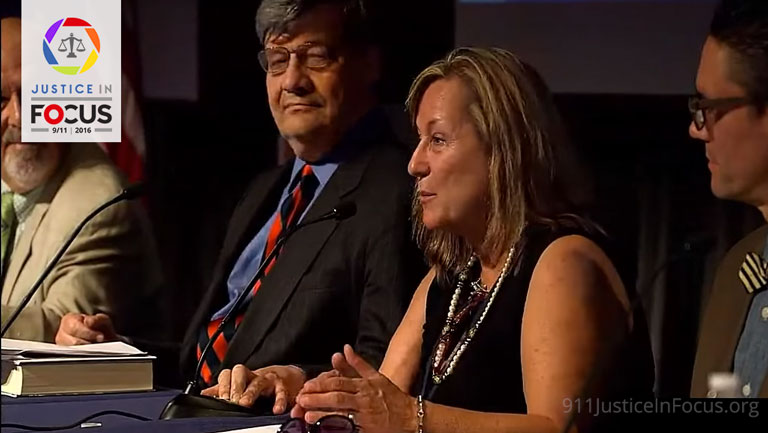
Sheehan introduced this segment. First, he explained the role of the attorneys as it relates to the technical evidence being presented: They filter evidence and advise on what standards must be observed in order that the evidence is admissible in court. To get discovery by the court, he said, extremely high standards must be reached.
Following Sheehan's introduction, evidence was presented to the attorneys.
Gage and his technical associates laid out the key pieces of evidence for the attorneys to review. First up was WTC 7's anomalous collapse. Gage providing an overview, Tony Szamboti discussed crucial structural nuances of Building 7, and Leroy Hulsey cited discoveries made in the ongoing UAF study of its failure.
Following Hulsey's presentation of evidence, Sheehan wondered whether, if one of his Ph.D. students had submitted an analysis as incomplete and negligent in attention to key elements of the collapse as the NIST model is, would the professor have flunked him? Hulsey's quick response: “Yes.” Sheehan then asked Hulsey, “On a scale of 1 to 100, how probable do you think it is that this building could have collapsed simply because of the fire?” Hulsey replied unequivocally: “Zero.”
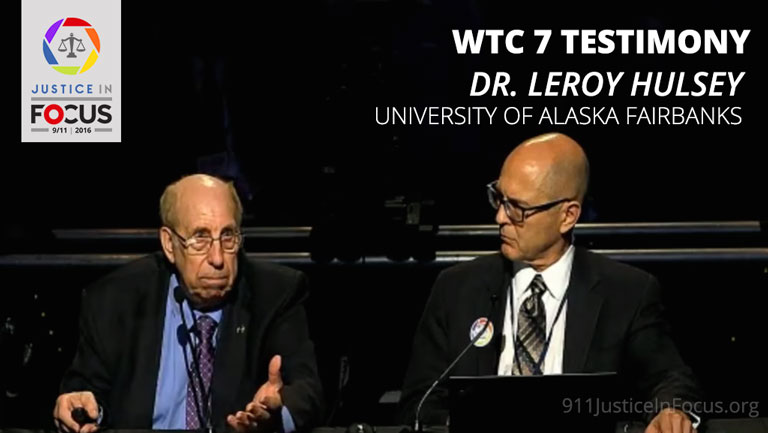
Another anomaly of the building's collapse was presented by David Chandler. He explained, via Skype, that the structure was, for the first 2.5 seconds, in virtual free fall — that is, falling at the speed of gravity.
In Chandler's words, “If something is dropping at free fall, it is converting all of its potential energy into kinetic energy. There is no extra energy available to do anything else. All of the breaking, bending, crushing, and throwing things around had to be done using some other energy source.”
“The energy for that activity could not have come from the free-falling building. During that 2.5 seconds of absolute free fall, the building fell through eight floors, or over 100 feet.”
“I made my measurements public on YouTube, and a number of us made official requests for NIST to correct their analysis. In the end, NIST changed the analysis in their final report to acknowledge free fall. That is tantamount to an admission that explosives were used.”
Supporting Chandler's calculations was the evidence offered by Steven Dusterwald, whose focus as a structural engineer is on the ductility of steel — the ability of the beams and girders to absorb energy when they deform. Dusterwald, who attended the symposium via Skype, made the point that Building 7's free fall could not happen when ductility is factored in.
Gage then presented evidence, via recorded media, of witnesses hearing explosions and of the actual explosions. He noted that NIST never included these accounts or mentioned explosions in its 2008 final report on WTC 7.
To illustrate the importance of evidence assembled by physicist Steven Jones — including evidence of molten steel, which was ignored by NIST — Gage introduced Jonathan Cole. Via Skype, Cole both explained and demonstrated (with video recordings) a few tests he has done. “I looked at several different issues on 9/11, and through the years put together a series of experiments that would either confirm or prove wrong various hypotheses.”
In his first experiment, Cole tested the claim made by Steven Jones of sulphur in the Ground Zero dust and the competing claim made by the BBC that the sulphur was from the drywall in the destroyed buildings. The experiment demonstrated that the BBC was wrong.
The most recent experiment that Cole conducted addressed the pancake collapse hypothesis and the pile driver collapse hypothesis. It showed conclusively that NIST's theory of fire leveling WTC 7, by either the pancake or pile driver method, is impossible.
The presentation of evidence then moved to the removal of steel from Ground Zero before it could be investigated. It also included the opinion of now-deceased controlled demolition expert Danny Jowenko, who confirmed that, in his eyes, the videotaped collapse of a 47-story steel-framed structure, which he later learned was Building 7, was indeed the result of pre-planted explosives.
Next up: Evidence pointing to the explosive destruction of the North and South towers.
As part of this presentation, Tony Szamboti informed the lawyers' panel that Northwestern University engineering professor Zdenĕk Bažant had submitted an analysis of the collapse of the Twin Towers for publication in the Journal of Engineering Mechanics (JEM) a mere two days after the buildings fell.
According to Szamboti, Bažant's paper — which NIST pointed to as an explanation of why there was a total collapse — contained many errors. Szamboti and colleague Richard Johns submitted a criticism of Bažant's analysis, identifying these many indisputable errors. But JEM rejected their paper as “out of scope” after holding it in review for more than two years, while at that same time, the magazine published an inane criticism of Bažant's work that Bažant easily rebutted.
The next round of Twin Towers evidence concerned the explosive lateral ejections of white smoke, pulverized concrete, and steel beams, all of which point to thermite having played a role in the destruction of the towers. Supporting this hypothesis, Cole's recorded experiment showed that, in fact, thermite (which becomes thermate when mixed with sulphur) could have been used to melt the steel and ultimately bring down the buildings.
From Copenhagen via Skype, Niels Harrit added weight to that view when he showed the red/gray chips gathered from the site, which he and a team of scientists studied and concluded was unreacted nano-thermitic material.
Moreover, Harrit cited corroborating evidence of the use of nano-thermite — metallic spheres of previously molten metal found in the World Trade Center dust analyzed by the RJ Lee Group.
He explained the significance of these discoveries this way: “We know that investigation or research into these kinds of energetic materials was initiated in the early 1990s — in particular, spearheaded by the Lawrence Livermore National Laboratory and also by the Los Alamos Laboratory in New Mexico. And we know this research has been going on in military laboratories in the United Kingdom and in France as well. We cannot prepare in duplicate exactly the same material as we have found in the World Trade Center dust.”
Erik Lawyer, a 25-year firefighter and emergency services veteran from Seattle, closed out the presentation of physical evidence by raising the question, via Skype, of whether or not 9/11 still matters. Lawyer's conclusion: “It does matter. And the reason it does matter is because 343 of my brothers were lost that day. Almost 3,000 people were killed that day. We're still at war. Our wars are escalating. We have ongoing deaths from the cancers and illnesses. We have millions of casualties from people who weren't involved in 9/11 in any way, and they're dying all over the world every day. We have 22 soldiers dying every day from suicide. That's from the military's own statistics. This is out of control.”
Lawyer then pointed to a great irony. “NIST is the National Institute of Standards and Technology. So they're the national institute on standards. Yet they did not follow the standards for fire and explosion investigation.”
Questions from the attorney's panel followed the presentation of scientific evidence.
Dave Meiswinkle asked Harrit about the chain of custody regarding thermite evidence. Harrit confirmed that there were four samples, all of which had a very good chain of custody. He added, “I do not consider our investigation as a standalone piece of forensic evidence. It must be seen in context, for the specific reason that this has not been duplicated by other investigators.”
“In the beginning, we were very hopeful that somebody else would pick up this and duplicate our work, but it hasn't happened. And the reason for this, I believe now, I have learned over the years, is that 9/11 is a 'no go' for our academic institutions. They have been very thoroughly gagged in the aftermath of 9/11. You may also turn it the other way around and say our results have not been challenged by any academic research, which in itself is a validation of our results.”
Bill Veale then queried Harrit: “Dr. Thomas Eagar of MIT has read your paper and said that the substance you have found is paint. Is there something that you can show us here that will demonstrate that's not true?” Harrit responded by suggesting that Eagar publish his work in a scientific publication, where it could be addressed according to the ordinary scientific procedures of academia. He added that if it were paint, it would have revealed itself as such in the tests that were conducted.
When asked by Mustapha Ndanusa if there is some other explanation for the presence of thermate at the World Trade Center, Harrit said “No.” He then explained that thermate contains sulphur, which is different from the nano-thermite found at Ground Zero. “Our findings cannot account for the sulfidation of the steel.”
Sheehan asked if there is any way to identify the source of the thermite. He made an analogy to the Silkwood case, where plutonium, found in Karen Silkwood's refrigerator, could be traced to Lot 29 at the company she worked for. Harrit explained that it would require cooperation from NIST and the military to answer Sheehan's question. David Chandler jumped in to say that nano-thermite is not available on the open market but is manufactured and used only in the military.
Finally, Meiswinkle asked each member of the scientific panel if, in their opinion, any of the three buildings could have collapsed due to office fires. Each responded with a definitive “No.” In a follow-up, Meiswinkle asked if the official story breaks the laws of physics.
David Chandler ticked off a number of physics-defying government claims about the destruction of the World Trade Center. “It violates conservation of energy, it violates conservation of momentum, it discounts Newton's laws of motion. I mean, it is a wildly fictitious report as far as trying to actually align with the laws of physics.”
To which Jon Cole added, “You cannot get molten steel from those fires. It violated the second law of thermodynamics — entropy laws. You cannot get thermite to be made naturally from what happened that day.”
Day Two Afternoon Session: Emcee Pepper Introduces Special Guest Ramsey Clark
The afternoon session began with Pepper announcing the presence of a special guest, former US Attorney General Ramsey Clark. Unable able to attend the symposium due to illness, Clark instead made himself available electronically via Mick Harrison's cell phone. Clark's voice carried throughout the Great Hall as he recited the final passage of Abraham Lincoln's 1860 Cooper Union speech: “Let us have faith that right makes might, and in that faith, let us, to the end, dare to do our duty as we understand it.”
Day Two Afternoon Session: Second Presentation of Evidence
Pepper then introduced Graeme MacQueen, a retired McMaster University professor of Religious and Peace Studies.
Dr. MacQueen focused on eyewitness evidence of explosions — of bombs going off throughout the WTC buildings.
He led off the topic this way: “We should think about the framing of this whole event. Frequently people suggest that it's obvious that these buildings came down because planes hit them and damaged them. And that was the original hypothesis. It's the natural hypothesis. And then people like me came slouching along after the event with our paranoid fantasies, conspiracy theories. We are revisionists. We are trying to change the original truth.”
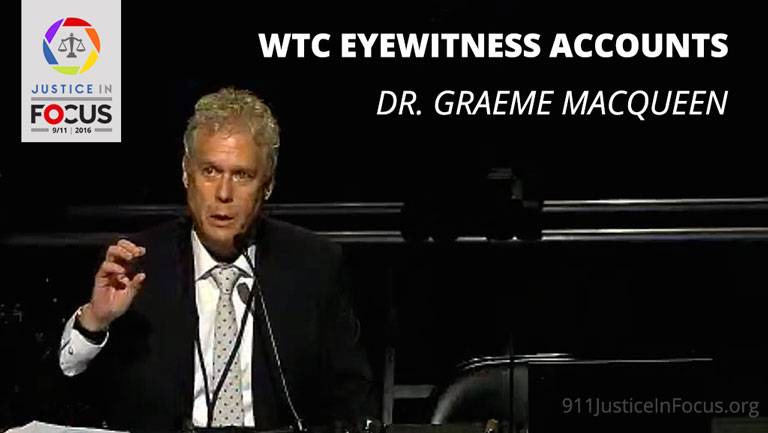
That's what the government wants citizens to believe. But MacQueen called this post-event narrative “historically false.” For “right after the destruction of the first building on 9/11,” he submitted, “both hypotheses that are being debated today were expressed. They were articulated. They were put forth. And neither one has priority in terms of time. The explosive demolition hypothesis was found all over the place on 9/11.”
After MacQueen offered plentiful video evidence to support his contention that explosions brought the buildings down, he concluded, “So my point is clear. It was an original hypothesis. We need no apologies for pursuing it. Our task is to choose between these two hypotheses which have raged since the morning of 9/11: Structural failure because of plane damage and planned demolition.”
Next MacQueen presented some of the eyewitness testimony he has amassed. As he did so, he informed the panel of attorneys that much of the assembling of these witnesses was accomplished against great resistance. Gathering evidence is normally a task accomplished by the FBI, but in the FBI's absence, truth-seeking civilians like MacQueen had to undertake it, he observed.
After presenting his corroborating evidence, MacQueen noted that although detractors raised objections to the claims of his 156 eyewitnesses, none of the objections was found to have merit. One objection was that eyewitnesses may have confused the sound of explosives being detonated with the natural explosions that often accompany fire. MacQueen refuted that contention, telling the panel, “There are three features of the eyewitness testimony that I especially want to draw your attention to. And I call them identification, pattern, and power.”
Identification. MacQueen explained that firefighters have ample experience in identifying ordinary explosions caused by fire. [They are: (1) boiling-liquid-expanding-vapor-explosions (called “BLEVEs”), (2) electrical explosions, (3) smoke explosions or “backdrafts,” and (4) combustion explosions.] Yet no one in the FDNY characterized the 9/11 explosions as such. Rather, he argued, “thirty-one separate members of the Fire Department of New York used the term 'bomb' when describing what they experienced.”
Pattern. MacQueen referred to a couple of videos he showed earlier, where witnesses “were talking about patterns of explosions, with regular intervals. . . . None of the natural explosions we would expect to accompany a fire exhibit that,” he noted. For example, in the first video, New Yorker Paul Lemos is quoted as saying: “I saw, from the corner, boom, boom, boom, boom, boom, boom, boom, boom, boom . . . just like twenty straight hits, just went down. And then I just saw the whole building just went 'pshew.'”
Power. The fact, declared MacQueen, is that “none of the explosions that typically accompany fire could destroy these massively robust buildings. And yet one eyewitness after another says that's exactly what they saw.” For example, firefighter Gary Gates, speaking of the South Tower, said, “I looked up and the building exploded. The whole top came off like a volcano.” That description rules out normal, fire-induced explosions, MacQueen concluded.
MacQueen wrapped up his presentation by pointing out how “extraordinarily deceptive” NIST's conclusions were. In the 4,000 pages of reports MacQueen read, NIST didn't list any of the abundant eyewitness testimony described during his presentation.
In this attendee's eyes, MacQueen was a magnificent witness, giving one of the most thorough and cogent presentations of the two-day event.
MacQueen's was the last of the presentations of evidence. On its heels, a panel of lawyers-only was convened, consisting of Meiswinkle, Ndanusa, and Harrison, with guest panelists Sheehan and Imposimato, to discuss legal standards relating to specific crimes and grand juries.
Day Two Afternoon Session: Legal Standards Related to Specific Crimes and Grand Juries
Mick Harrison kicked off this session by focusing on federal legal standards. He contemplated the creation of a federal grand jury, future civil litigation, a felony complaint in New York, and the creation of an international forum in pursuit of a possible prosecution of 9/11 crimes. He then laid out the various laws that had to be considered.
Mustapha Ndanusa, a New York-based litigation attorney with experience in state and federal cases, presented details of the legal aspects of the case as it moves forward, with a focus on New York State law. In his presentation, he clarified differences between petit juries and grand juries and explained other nuanced New York-specific legal standards.
Dave Meiswinkle, a New Jersey-based defense attorney, focused on New Jersey standards as they may pertain to the crimes of 9/11. He posed two questions. First: “Does New Jersey have legal connection or nexus to the crimes of 9/11?” Second: “Does New Jersey have legal standing to investigate these crimes and criminally charge suspects?” His answer: “I would say categorically 'Yes.'”
How so? There were over 681 victims from New Jersey. Flight 93 was hijacked out of Newark. There were anthrax attacks in the New Jersey cities of Trenton, Princeton, and Hamilton. Terror cells operated in both Patterson and Wayne, New Jersey. The hijackers trained at two airfields in New Jersey. Hundreds of tons of WTC steel were sent to New Jersey, where the steel was cut up before being shipped to Asia.
Meiswinkle ended his presentation by deferring to a guest he had invited to accompany him at the table — a board on which was written the words “Bill of Rights.” He said that his purpose in displaying this hallowed document was to remind everyone of the Fifth Amendment's opening words, which read: “No person shall be held to answer for a capital, or otherwise infamous crime, unless on a presentment or indictment of a Grand Jury, . . . .” He called the grand jury a “people's court” because its impaneled members, not the prosecutor or the judge, decide whether or not to indict. As Meiswinkle phrased it, “The grand jury does not assist the prosecutor. The prosecutor assists the grand jury.”
Guest panelist Sheehan weighed in. Drawing on his experience in federal litigation and in facing many huge legal hurdles, he discussed the difficulties of bringing evidence before a grand jury. Sheehan recommended that the panel's energies be focused on civil litigation, though the case, he allowed, can be prosecuted as if it were a criminal case.
Fellow guest panelist Imposimato explained that in Italian courts, the prosecutor is the one who requests a grand jury; it is impossible for the victims themselves to make the request. Assuming a grand jury were convened with the goal of prosecuting the perpetrators, Imposimoto raised the question of who might be so named.
Harrison then spoke to the issue: “My view of federal law is that if there is evidence of a crime — and we've heard quite a bit of evidence of a crime — not only can citizens present that information to a prosecuting attorney or, in New York, a judge, or maybe in New Jersey, a judge, for the purpose of having it transmitted to a grand jury, the grand jury can be initiated and inquiry can proceed on that crime prior to suspects being identified. But no presentment or indictment can proceed to be issued until the suspects are identified.”
Following Harrison's assessment, Pepper took the podium to introduce the next session, which employed the same panel of lawyers but this time dealt with legal standards applied to evidence and addressed the issue of whether or not a grand jury is warranted.
Day Two Afternoon Session: Legal Standards Applied to Evidence — Is a Grand Jury Warranted?
Sheehan offered his opinion that the crimes of 9/11 should be pursued using private attorneys in a civil context. “There's not more than a 1% chance, in my opinion, that any present federal judge or prosecuting authority would allow the petition to be put in front of a grand jury.” He explained further that the extraordinary nature of the 9/11 crimes creates unusual requirements necessary to prosecute them. Furthermore, Sheehan warned, “The judges who have been appointed in the last decade and a half, at all levels, are not disposed toward unorthodox procedures.”
Agreeing with Sheehan, Judge Imposimato added that it may be prudent to pursue the case, in parallel, in a criminal context as well.
Ndanusa expressed his opinion that, while legally a grand jury is warranted, practically speaking it is not advisable at this time. He argued that building a larger audience for the evidence of the crimes of 9/11 may make a criminal investigation before a Grand Jury down the road more practical.
While acknowledging Sheehan's prudence, Meiswinkle was adamant about aggressively pushing forward to get the evidence in front of the public. Referencing the compelling presentations made earlier in the symposium by Gage et al., Meiswinkle insisted upon the importance of getting the information in front of a grand jury. “Codify it, put it all together, as these architects and engineers are doing. . . . Get that information to the attorneys. Let us run with it.” He added, as a nod to the parallel tracks idea, that “we'll run with it differently: criminal, civil, and with a citizen's group.”
Harrison agreed with Sheehan's suggestion that the most prudent course is civil litigation, but he also found Imposimato's parallel tracks advice synergistic. Harrison then brought light to federal statute Title 18, Section 3332, which can be used to initiate a grand jury. He posited that if a request is made by an attorney who provides evidence of a crime, the wording of the law may force a prosecutor to pass that evidence to a grand jury.
Day Two Afternoon Session: Questions Regarding the Evidence Presented and the Legal Analysis
Pepper introduced a Q&A session with several questions from the audience. “Can the shareholders bring a suit against the World Trade Center insurance companies for failure to investigate insurance fraud?” was directed to the lawyers panel and answered by Sheehan. He explained how such an action may work within the framework of expanding on the Motley Rice lawsuit. Because the courts want to give the appearance that they are functioning the way people expect them to, added Sheehan, they are susceptible to public scrutiny and will therefore attend to the rules if they know they're being watched.
When Pepper read the question, “How come Bush, Cheney, and Rumsfeld have not been mentioned at all?” Veale chimed in, “Stay tuned!” Harrison, in a serious tone, clarified a key strategy of the attorneys: “It's been an intentional decision on our part not to talk about suspects in this proceeding.”
To the question, “Was NIST negligent, and if so, what are the legal consequences of their negligence?” Veale responded: “NIST was way more than negligent. NIST was involved in scientific fraud. They'd be way down the list of suspects in my mind in terms of the time, energy, and resources you would put into getting them, but they were essential to the cover-up. I gave up using the word negligence in regard to this case years ago.”
Harrison added his thoughts: “If it walks like a duck and quacks like a duck, it's probably a duck. This does not walk and quack like negligence. It walks and quacks like intentional [mis]conduct.”
“There's also another famous saying from Sir Arthur Conan Doyle through his character Sherlock Holmes that when you've eliminated the impossible, whatever remains, however improbable, must be the truth. And at this point, before looking at the evidence, if you just ask yourself, 'Is it likely that this could have been an intentional act to destroy these buildings?' most of us would say, 'It's improbable.' Being improbable doesn't mean it didn't happen.”
“And I think what we've heard today — and this is my personal opinion from the scientists and engineers — [is that] the laws of nature don't change from day to day, so I think we've eliminated the impossible. And what remains, even though it is improbable, must be the truth.”
Meiswinkle jumped in to insist, “We're not even talking about negligence or criminal negligence. We're talking about intentional fraud and deception, fabrication, et cetera, by people who are very educated scientists and professionals.”
Day Two Afternoon Session: Lawyers' Committee for 9/11 Inquiry Legal Campaign Strategy
What will be the lawyers' legal campaign strategy moving forward? The first avenue the lawyers panel discussed was whether or not the crimes of 9/11 could be pursued through international litigation. The attorneys were all cognizant of the fact that the 9/11 victims came from countries the world over, not just the US — a fact that broadens the range of venues where potential relief could be sought.
Pointing out that 65 British citizens were the victims of September 11th, Italy's Judge Imposimato suggested to UK barrister Pepper, “If we can stay in contact, I think that we can start, together, a prosecution in Italy and in Great Britain. I am ready to do so, and I will be in contact with you after we leave.” His offer prompted enthusiastic applause throughout the auditorium.
Pepper indicated that while the US does not accept the jurisdiction of the International Criminal Court (ICC), European countries do when there are European victims of a crime.
The discussion then moved to Freedom of Information Act (FOIA) requests.
Jane Clark indicated that there are many FOIA requests in the hopper, including an insider trading-related request for Securities and Exchange Commission action, headed by California attorney Doug Mackenzie, and “19 or more” requests initiated by AE911Truth researcher David Cole and a Washington, D.C., attorney. Clark also highlighted a pending FOIA request she is working on that has been made to the US Department of State (concerning an ambassador during the Bush Administration) and that may go to litigation.
Following up, Harrison embraced the efficacy of FOIAs by sharing an amusing anecdote. He told about he was asked by an organization he was working with in Bloomington, Indiana, called the 9/11 Working Group of Bloomington, to make a FOIA request. The document they received back, said Harrison, “showed that one of the hijackers — or at least one of the supposed hijackers — had applied to renew his pilot's license and had been subjected to a medical exam, after 9/11.” Oh, the wonders of modern medicine!
Following the FOIA discussion, Ndanusa walked the audience through the important elements of convening a grand jury and detailed complaint procedures in New York. The discussion then turned to the significance of the newly released 28 pages.
Barbara Honegger took the podium, remarking, “The tide is turning. The official story is now the conspiracy theory. The 28 pages have finally been released after 14 long years of cover-up. The Justice Against Sponsors of Terrorism Act, JASTA, has passed both the House and the Senate. . . . When President Obama signs it, or when Congress overrides his still-threatened veto, the reportedly 9,000 9/11 victims' family members of the attacks, their legal case against the Saudis for their claimed complicity in supporting the alleged hijackers (and more on the word 'alleged' in a moment) will finally be able to go forward in the courts.”
Over applause from the audience, Honegger then referenced Sheehan, who called the September 11 attacks “one of those high crimes that cause the very foundation of the law to tremble.”
In support of Sheehan's assertion, she stated, “A member of the Parliament of France, who is the equivalent of our chairman of the Senate Foreign Relations Committee, said, after the unanimous House vote for JASTA, that if JASTA becomes law it will 'cause a legal revolution in international law.'” [JASTA was passed unanimously in the Senate and House and its presidential veto was overridden.]
“We are truly at a hinge of history,” Honegger concluded. “And as Danny Sheehan passionately reminded us yesterday, at the end of his presentation, once the jury realizes that they have been lied to and deceived by the other side, they turn. And that it is our job that we have taken on here today, to bring the American people, indeed the public of the world, to that turn.”
Les Jamieson then took the podium and, utilizing slides, explained that vital information contained in the 28 pages showed incontrovertible connections between FBI informants and assets that reveal the likelihood of 9/11 being an inside job.
“Also within the 28 pages,” he added, “I noticed some very big contradictions.” One of those contradictions had to do with official claims denying that there had been FBI investigations into Saudi activity when, in fact, a timeline Jamieson generated from information culled from the 28 pages showed multiple inquiries dating back to 1993.
Harrison closed the discussion with a startling revelation. It was the executive branch that chose to classify the 28 pages, though that authority is vested in the legislative branch. But when Congress, in committee proceedings, asked to declassify the 28 pages, “they didn't seem to understand that, once having made that conclusion, they had an obligation to publish those proceedings,” according to Harrison. “Congress had not determined, in its own opinion, that there was a need for secrecy. So we suffered under that secrecy imposed by the executive branch illegally, unconstitutionally, for 14 years.”
Day Two Afternoon Session: US Litigation and Future Investigations Strategy
Sheehan implored the panel to “view what is happening here as a Rule 11 investigation” — that is, to make it a full-scale professional investigation, held to the highest of standards of specificity, and thus avoid giving any federal district court the opportunity to dismiss the evidence out of hand.
Meiswinkle called for the 9/11 investigations to be expanded beyond the New York City attacks to include the Pentagon and Shanksville. He argued that there may be evidence in these locations that ties up loose ends and creates a more complete picture of 9/11. When we fight back against the crime of 9/11, Meiswinkle said, we need to remember our roots and view it as an attack on our Bill of Rights.
Veale recalled a lawsuit he brought on behalf of Pentagon employee April Gallop who survived 9/11.
“I represented April Gallop against Dick Cheney, Don Rumsfeld, and General Richard Myers. I was called delusional by [Judge] Denny Chin in the district court in New York. I was sanctioned twice by the Second Circuit, once for suggesting that the existence of John Walker on that panel was improper. Who was John Walker? He was President George Bush's first cousin, once removed. And he was there along with Judge Winters and Judge Cabranes to decide whether or not President Bush's appointees had committed mass murder and treason. I was sanctioned twice, and I made a very understandable and egregious mistake that still stands in the shadows today, and yet I've never been more proud of what I did.”
“April Gallop was a soldier at the Pentagon and she was there with her tiny child . . . went to do some last minute record checking before she delivered her child to day care — her first day back after maternity leave — and she turned on her computer and the place exploded. She managed somehow to save herself, and her child, and help, apparently other people to get out onto the lawn, and she survived. She went to the hospital and she was treated horribly by operatives from the Pentagon, who tried to recruit her to a story which she could not believe. And in the weeks and months and years from that time, she could not conform her memory to the story that was being told in the newspapers and on television.”
“So we filed a lawsuit on the 15th of December, 2008, and we accused Dick Cheney, Don Rumsfeld, and General Richard Meyers of mass murder and treason for their complicity in these attacks. That lawsuit was dismissed by Denny Chin with more or less the following words: 'It is simply not plausible that the Vice President of the United States, the Secretary of Defense, and other high governmental officials would conspire to enable attacks which led to the death of 3,000 Americans.'”
“I maintain that when the judge wrote those words he abolished the length and breadth of human history. There were three notions that I wanted to say to the Court of Appeals when I argued the appeal from the dismissal. The first was that evil exists in the world, the second is that it is attracted to power, and the third notion I didn't think I would have to say to anyone six years old or more [is that] it has no regard for citizenship.”
Veale implored his listeners not to let 9/11 become another JFK.
Day Two Afternoon Session: Closing Remarks
Honegger waived a PowerPoint presentation she had prepared to instead “bounce off” other comments made by earlier presenters. Citing Judge Denny Chin's remark about the implausibility that high-ranking officials would conspire to enable attacks that led to the death of 3,000 Americans, she recalled a “legal action in Italy against a very high-ranking former official of the US State Department and also special ops and CIA — Steve Pieczenik.”
According to Honegger, Pieczenik acknowledged that Operation Gladio was a Pentagon, CIA, and NATO operation that conducted terrorist attacks against innocent civilians throughout Europe, including Italy, admitting they were responsible for the 1978 kidnapping and assassination of Italian Prime Minister Aldo Moro.
More recently, according to Honegger, Steve Pieczenik said that he knows, “and is willing to name, under oath, through the proper legal venue, the military General on then-Deputy Secretary of Defense Paul Wolfowitz's military staff, who confirmed to him, Pieczenik, that September 11 was a false flag attack and a homeland Gladio operation. 'They ran the attacks,' Wolfowitz's General told Pieczenik of Wolfowitz himself, Vice President Cheney, Cheney's top national security aide Steven Hadley, Elliott Abrams, National Security Advisor Condoleezza Rice, all named by name, and he says just get in touch with him when there is the appropriate legal forum.”
Honegger urged supporters to proceed with their eyes open; to remember that even if a congressional investigation takes place, there are, at the top, “Deep Staters” who have little party loyalty; and to be aware that even in successful investigations, such as the Iran-Contra hearings, the likelihood of a cover-up is great.
Harrison closed the symposium with a motion: “My proposal to the board is that the board authorize The Lawyers’ Committee for 9/11 Inquiry, from today on, to begin the preparation, including any necessary investigation of civil litigation, on the issues that have been discussed today, and to begin building a legal team as resources become available, and to begin soliciting those resources for that work, and parallelize the preparation and filing of a request for a federal grand jury, and, as we determine appropriate, a New Jersey or New York grand jury.”
“That's my motion. Any second?”
The motion was seconded and, by unanimous consent, carried.
A Final Acknowledgement
Heartfelt thanks to the courageous activists, scholars, journalists, attorneys, filmmakers, scientists, architects, and engineers who took part in the JUSTICE IN FOCUS symposium, either in person or via Skype or Mick Harrison's cell phone, who have sacrificed, and continue to sacrifice careers, friendships, and marriages in pursuit of truth and justice, and who, through painstaking research, hard work, and dedication, have joined to lay bare the truth of 9/11 — not only to open our eyes, but to shine a light on a path forward so that, even in darkness, we can see. And, as Mark Crispin Miller joked, “If we see something, say something.” Maybe it's time now we do something.


